
Monday, March 14, 2005:
Well, today was a Vatican day. Much to our dismay, we arrived to find a line of visitors queued up for the Vatican Museum and Sistine Chapel that wrapped around three sides of the walls of Vatican City. I knew my feet would not survive a three hour stand in line so I thought we might have to forgo the Sistine Chapel. But I suggested to Pat that we check out the interior of St. Peter's Cathedral and the Pieta and see if we could at least see that.
Much to our pleasant surprise there was only a short line there. So we went inside and I proceeded to photograph practically everything I could get a decent shot at in the low light - in that large of space, the shutter speed is still pretty slow even with the flash. But I see a number of them turned out okay. Of course the Pieta was absolutely breathtaking. I took photos as best I could then just gazed at it to try to remember as much of the experience as I could. I understand it is the only statue on which Michelangelo chiseled his name. I guess he became quite upset when he overheard someone discussing the sculpture and attributed it to one of his rivals.
"The Pieta is considered to be the masterpiece of his early years, deeply poignant, exquisitely beautiful and more highly finished than his later works were to be. In creating a harmonious pyramidal group from the problematic combination of the figure of a full-grown man lying dead across the lap of his mother, Michelangelo solved a formal problem that had hitherto baffled artists." - From "The Bulfinch Guide to Art History"
It was sad that this magnificent piece of art has to be protected by a bullet-proof glass enclosure now after some deranged individual attacked it with a hammer.
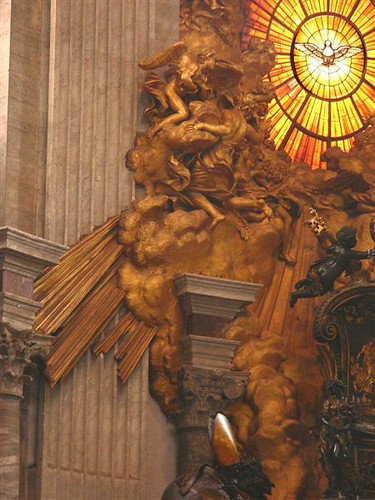
We then wandered around the cathedral taking pictures of various sculptures and of course the high altar and the Pope's ornate bronze canopy.
Most of the interior decoration of St. Peter's, including the high altar, is the work of Gianlorenzo Bernini (1598-1680).
"Bernini was a sculptor, painter and architect and a formative influence as an outstanding exponent of the Italian Baroque. He was an exceptional portrait artist and owes to his father his accomplished techniques in the handling of marble and also an impressive list of patrons that included the Borghese and the Barbarini families. Bernini originally worked in the Late Mannerist tradition but rejected the contrived tendencies of this style. By 1624 he had adopted an expression that was passionate and full of emotional and psychological energy. His figures are caught in a transient moment from a single viewpoint, bursting into the spectator's space." - From "The A-Z of Art: The World's Greatest and Most Popular Artists and Their Works", by Nicola Hodge and Libby Anson
"Bernini was made a papal knight at the age of twenty three. A year later his chief patron, Maffeo Barberini, was made Pope Urban VIII, and immediately summoned the sculptor: 'It is your great good luck, Cavaliere, to see Maffeo Barberini pope. But we are even luckier in that the Cavaliere Bernini lives at the time of our pontificate.' Urban reigned for nearly twenty-one years, during which Bernini was the most grandly employed, and richly rewarded, artist in the world. In the mid 1640s, under the new pope, Innocent X, Bernini was (probably unfairly) blamed for cracks in St Peter's bell towers, which had to be pulled down. But he was soon back in favour and continued to serve the papacy under Innocent and his four successors, for another thirty-five years, making fifty-six in all.
During this long and intensive service, Bernini effectively completed the setting and interior of St Peter's. Indeed his contribution to the church as we see it today is greater than that of any other artist, including Michelangelo. He did three principal things. The main fabric was completed in 1626 and Bernini was charged with ennobling its interior. He did this first by constructing (1623-24) an enormous baldacchino over the high altar. He placed four immense marble bases at each corner, and on them constructed colossal gilt bronze columns, wrought into spirals and joined by a cornice, with angels, each twice life-size, guarding its crowned superstructure. It is a work of complete originality, for nothing like it has been built before or since (apart from smaller copies). There are those who believe that Bernini's contemporary and (at times) rival, Francesco Borromini (1599-1667), provided some ideas. Maybe he did, but the work as it stands has the impress of Bernini's artistic character all over it. While working in and around the Vatican, Bernini also provided, as a setting for his wonderful St Teresa, the architectural and painted embellishments of the Cornaro Chapel (1644-55). This too was completely original, for no one before had combined together, in a single artistic design, and on the largest possible scale, marble and stone, brass and gilt, gold and silver, plain and stained glass, all wrought together to produce a single emotional spasm. The divine dove descends, skeletons arise from the pavement, angels swirl around and crown the scene with flowers, while all the time, in the centre, Teresa writhes with joy. It is an amazing composition which drew admirers from all over Europe, and was imitated by all who had the means.
It inspired the papacy to demand from Bernini a similar artefact, on an even larger scale, to complete the main decoration of the interior of St Peter's. This is the famous Cathedra Petri, or Peter's throne, in effect a gigantic reliquary, which forms the climax of the view along the nave, and is framed by the baldacchino columns. It is a complex piece of sculptural architectural confectionery, made up of red jasper, black Sicilian marble, masses of bronze, some gilt, stone, iron, marble statuary, a yellow glass eye, through which the light pours, and golden stucco clouds. The size is staggering but is perfectly in scale with the huge dimensions of the building. Bernini continued his work inside the church by shifting around various papal tombs, and designing new ones, and creating a suitably grandiose setting for the spectacular papal collection of relics - for most visitors their main object in coming to St Peter's. Finally, he put into the Vatican Palace, adjoining the church, a regal staircase, the Scala Regia, through which princes progressed upwards to the papal apartments. In an ideal world, he would have pulled down the entire palace, externally an eyesore which remains to this day and spoils the total prospect. But this could not be done, at any rate in those days, without demolishing the magnificent frescoes, by Raphael and others, on its internal walls. So Bernini was left with an awkward site for his stairs, a problem he solved by a brilliant piece of trompe l'oeil foreshortening which makes the stairs seem longer, grander and steeper than they actually are, and has to be seen to be believed. It is even more ingenious than Michelangelo's stairs in the Laurentian Library, if not as beautiful.
Finally, Bernini transformed the small existing piazza in front of St Peter's into the largest and grandest square in the world, or rather a key shaped device of colonnades, which branch out from the church in a narrowing stem, then form into two halves of a circle, which encompasses an obelisk and two fountains. The circle was intended by Bernini to be closed by a third colonnade, which screened the whole from the visitor approaching from the Tiber. But this was never built, and in 1939 Mussolini hacked through an avenue which spoils the surprise. Even so, there is nothing like it anywhere in the world, for the colonnades, despite their grandeur, are low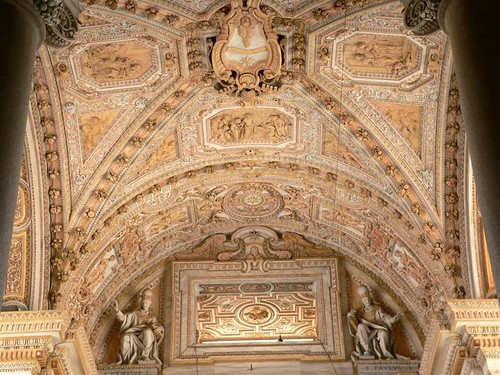 by comparison with St Peter's facade, which thus continues to dominate the whole and appears to stretch out arms to gather in the faithful - clearly Bernini's master idea." - From "Art: A New History", by Paul Johnson.
by comparison with St Peter's facade, which thus continues to dominate the whole and appears to stretch out arms to gather in the faithful - clearly Bernini's master idea." - From "Art: A New History", by Paul Johnson.
The paintings in the domes were very beautiful and Bernini's richly embellished ceiling looked like decorative icing on a wedding cake.
As we emerged from St. Peter's, we saw the Pope's guards in medieval costume traditionally said to be designed by Michelangelo.
"When the company was founded, in 1505, the soldiers wore simple tunics, but in 1548 the present uniforms were adopted. A long-standing tradition holds that they were designed by Michelangelo, but there is no foundation for this belief. As well as their everyday costumes, the Swiss Guards have suits of armor, with swords weighing thirty kilos, but these are used only for escorting the Pope during special ceremonies in St. Peter's.
At the beginning of the 16th century the Vatican began to employ Swiss mercenaries, who had a reputation for faithful and disinterested service. During the Sack of Rome in 1527, when Charles V of Spain devastated the city with his army of "lanzichelecchi", it was only the quick reaction of the Swiss Guards which enabled Pope Clement VII to take refuge in Castel Sant'Angelo; 147 Swiss soldiers died in the fighting. The invaders occupied the Vatican buildings, causing untold damage: they used ancient manuscripts as bedding for their horses, lit fires on the marble floors and scratched graffiti on the frescoes.
The Cohors Helvetica currently numbers 107: the commander, five officers (including a chaplain) and 101 soldiers, all of Swiss birth. Until about 30 years ago, only citizens of the German-speaking cantons were eligible for admission to the company, but in recent years there has been a dearth of candidates and now French- and Italian-speaking nationals can also enrol. They must be Roman Catholics, unmarried, between 18 and 25 years of age, and they must also be good-looking. Officially they are supposed to be over 1.74 meters tall, but nowadays this regulation is not enforced too strictly. Their pay is not very high - the equivalent of just over 1,000 U.S. dollars per month, paid in Swiss francs - but they are given full board and lodging.
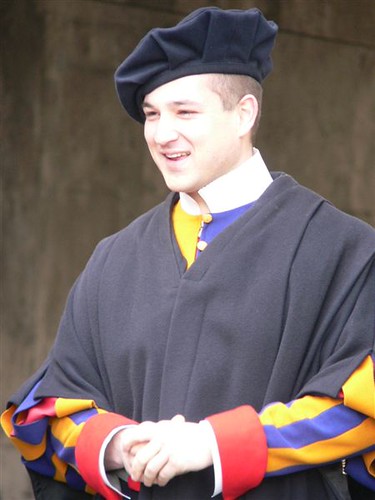 Every year on May 6, anniversary of the Sack of Rome, the Swiss Guards renew their vows of allegiance in the Courtyard of San Damaso inside the Vatican. In a colorful ceremony, new recruits kneel down, raise three fingers of their right hand to symbolize the Trinity and swear to serve the Pope "to the death". - InfoRoma
Every year on May 6, anniversary of the Sack of Rome, the Swiss Guards renew their vows of allegiance in the Courtyard of San Damaso inside the Vatican. In a colorful ceremony, new recruits kneel down, raise three fingers of their right hand to symbolize the Trinity and swear to serve the Pope "to the death". - InfoRoma
We then strolled over to the Vatican Post Office to send some postcards and I found some wonderful books about the artwork of
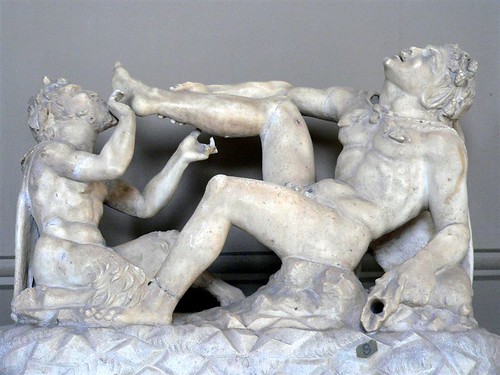 St. Peters, Michelangelo and the Sistine Chapel and a gold papal medallion depicting a scene of the Madonna from one of Leonardo's paintings.
St. Peters, Michelangelo and the Sistine Chapel and a gold papal medallion depicting a scene of the Madonna from one of Leonardo's paintings.Apparently the Vatican releases one each year but I preferred the art on the 2002 Medallion to the scene on the 2005 Medallion. Maybe I can find more on Ebay - oh oh - another collection!
We stopped by a food cart for a sandwich and were charged 21 EUR for two sandwiches and two bottles of Coke. I told Pat it was sacriligous to rip people off right under the Pope's nose but Pat said the Coke was probably specially blessed by the Pope to make me feel better about it.
Afterwards, we stopped by a nice gift shop and I found some delicate cameos for my sister Jane, a cross with medieval artwork for my minister sister, and a detailed figurine of the Capitoline wolf for me.
As we walked back towards the Metro, we saw that the line to the Vatican Museum was gone so we excitedly headed towards it. Although we found that the Etruscan gallery was closed, we were able to see some of the Roman sculptures.
We then followed the sea of humanity flowing toward the direction of the Sistine Chapel. On our
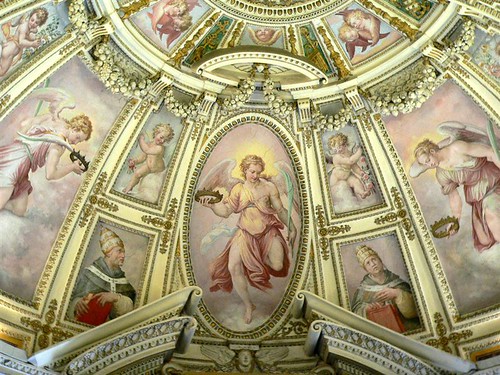 way to the chapel we strolled through the famous Hall of Maps. I was simply awestruck by the riotous colors of art in the Hall of Maps. I actually enjoyed the images in the Hall of Maps more than the Sistine Chapel. (Is that considered sacrilege?) Of course the Sistine Chapel was unforgettable, too. Personally, I like the bright hues of the paintings since they have been cleaned and restored. In one of the books I purchased it showed the difference between the soiled paintings and the restored paintings and there is simply no comparison. Michelangelo's delicate flesh tones and rich colors of clothing and landscape are once more visible to an appreciative audience.
way to the chapel we strolled through the famous Hall of Maps. I was simply awestruck by the riotous colors of art in the Hall of Maps. I actually enjoyed the images in the Hall of Maps more than the Sistine Chapel. (Is that considered sacrilege?) Of course the Sistine Chapel was unforgettable, too. Personally, I like the bright hues of the paintings since they have been cleaned and restored. In one of the books I purchased it showed the difference between the soiled paintings and the restored paintings and there is simply no comparison. Michelangelo's delicate flesh tones and rich colors of clothing and landscape are once more visible to an appreciative audience.Upon emerging from the Vatican, I thought of the dean's wife who loves the Italian version of ice cream called gelatto so we stopped by a cafe for a cooling dish of rich vanilla gelatto and fresh strawberries. We returned to our hotel for a brief rest and to prepare the roses Pat brought to place on Caesar's bier tomorrow on the Ides of March and I went online to reserve the car for Pompeii.
Richard (my co-moderator of the Imperial Rome discussion group) will be arriving tomorrow and is our designated driver for our Pompeii, Ostia, Tivoli, and Florence road trips.
Pat remembered she had seen a web page on the internet with pictures of Roman catapults and a caption that said reproductions of these types of Roman military equipment were located in the Museum of Roman Civilization. I looked it up on the web and we found it is about 3 1/2 miles from our hotel on the blue Metro line. So, if we aren't too tired after our trip back to the Forum tomorrow and our exploration of the Roman Wax Museum, we will catch the Metro down to the Museum of Roman Civilization.
We concluded the day with a light dinner at a restaurant close to the hotel that we have visited several times. The waiter has become friendly enough with us that he is now joking with us. Tonight I ordered a calzone wood style which is a calzone filled with cheese and mushrooms. I also ordered a tomato salad and was surprised to find that when you order a tomato salad you are brought a plate of sliced cherry tomatoes garnished with a few sprigs of watercress. So, Pat donated some lettuce garnish from her ravioli and some black olives that had been placed on the butter plate for decoration and I produced an American-style salad. I noticed the waiter passed our table and looked a little confused when he saw what I had done with the salad.
We topped the meal off with a dish of mousse.
1 comment:
Hi,
just wanted to say your blog was very interesting. I am an ancient history stuent currently doing my last year of high school in Australia. You seem to enjoy all things ancient :) i do also. I'm currently studying ancient Greece and Rome. I'd love it if you had any information to share...
Post a Comment